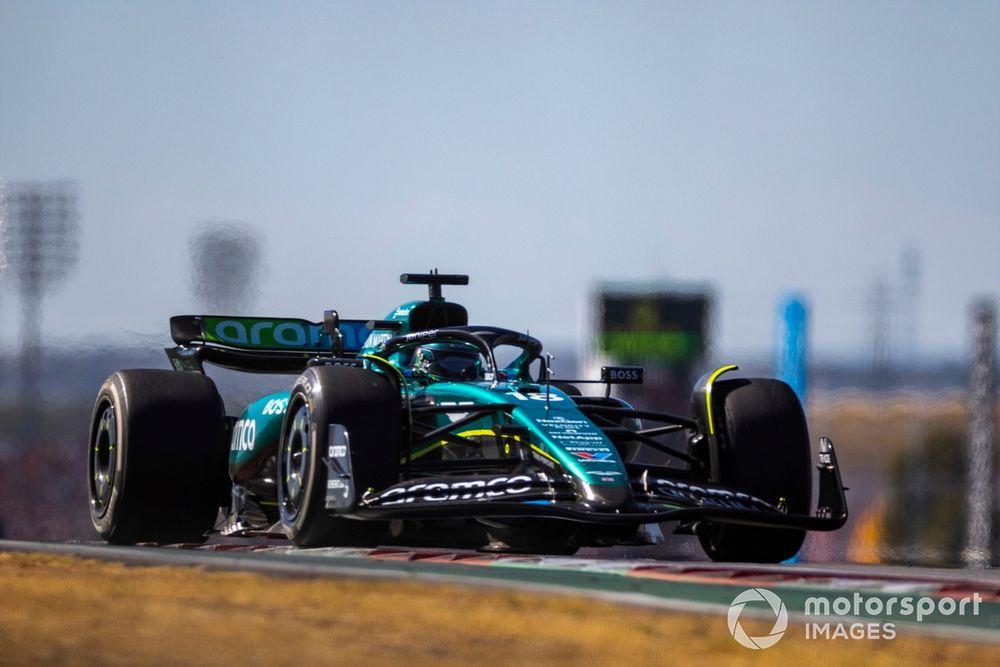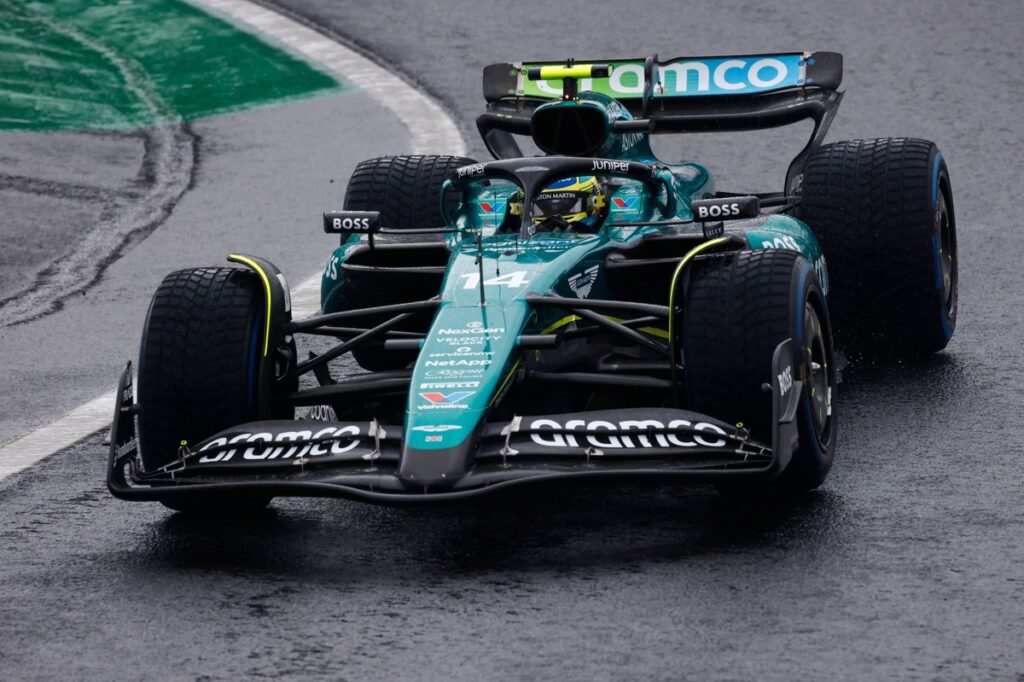Twelve months ago, Aston Martin left the Brazilian Grand Prix with a podium finish that pointed to the outfit finally having some answers about its car as it headed into the winter.
Fast-forward to now and things could not be more different, as the squad left Interlagos scratching its head over problems in the wet race and still short of a solution for its drop of form this year.
Perhaps most alarming of all, for a team that started the year neck and neck with Mercedes, is that in the dry last weekend its race pace was the slowest out of everyone.
It’s something that Fernando Alonso was more than willing to point out, as he hinted at the miracle of some impressive times in Sunday morning’s wet qualifying session before he crashed.
“We are taking huge risks,” he said. “We are the 10th fastest team in the dry and then we were P2 in qualifying…so it shows the level of commitment we had.”
Analysis at its Silverstone factory this week at least gave the team some answers as to its wet-weather struggles – and especially the brake problems that pitched Lance Stroll into the wall on the formation lap and worried Alonso all afternoon.
The conclusion is they were triggered by imbalance issues as the result of changing floor specs from qualifying into the race.
Switching after its double qualifying crashes from its planned Suzuka concept to the version it introduced in Budapest resulted in the car’s aero and mechanical platform not being ideal – hence a lot of rear-locking.
While those issues have been quickly understood, what the team is still chasing right now is a solution to its relative lack of performance against the opposition.
Switching floors
Fernando Alonso, Aston Martin AMR24, in the pits
Photo by: Zak Mauger / Motorsport Images
In the wake of a new floor that was introduced at the United States Grand Prix not delivering what was hoped for, Aston Martin has found itself having to mix and match upgrades and old concepts to try to find the best platform.
Experiments in Mexico confirmed that for low-speed circuits a version of the Suzuka floor concept – which the team also intended to run in Brazil before its plans were forced to change because of the qualifying crashes – was best.
Aston switched to the Budapest version, which is better suited for higher-speed tracks and will likely be used in Las Vegas and Qatar.
From the outside, these floor experiments could suggest that the squad is a bit lost in trying to work out what to do.
But it is actually part of a route that it has taken from the off – and is not a million miles away from what it did 12 months ago when it ran an old floor design in Abu Dhabi just to fully understand where progress had or had not been made.
As Aston Martin performance director Tom McCullough said: “We’ve had two main floor philosophies this year, and we’ve iterated and developed both of them as they sort of suit different tracks and, as you notice, we’ve sort of gone between the two of them.
“The floor that we brought to Austin was trying to sort of do best of both worlds really, and was a bit of an experimental floor understanding for next year.”

Lance Stroll, Aston Martin AMR24
Photo by: Glenn Dunbar / Motorsport Images
Actually unleashing a dramatic step forward in pace on track is not key to Aston Martin’s definition of success right now, with its floor experiments likely to continue until the final race. Instead, it’s about increasing its knowledge base and applying the learnings of why it has not made the hoped-for progress this year onto its 2025 challenger.
That is why it used free practice in Mexico to concentrate on extensive aero mapping of its car, rather than work through the typical high-fuel programme that others were doing to prepare for the weekend.
McCullough added: “I think, looking at the way the AMR25 developments are going at the moment, which is in effect an evolution of the philosophies that we’ve adopted, we’re making quite good strides in the wind tunnel.
“But it’s a relative game. I think the learning that we got from [Mexico], with all the aero rake correlation work and other stuff we’re doing, it sort of feeds into that. We haven’t brought the parts to the track that have really made the big difference, and that’s clearly the target for the start of next year.”
Aston Martin is certainly not shying away from the fact that it has not delivered what it wanted to this year.
Speaking this week, team principal Mike Krack said: “It’s been our toughest season because we haven’t met our own expectations. We set ourselves the challenge of creating a car that we could continually develop to compete with the top four teams, and we’ve fallen short of those ambitions.
“We have to be honest about that. We have to accept the situation, learn as much from it as we can, understand any mistakes we’ve made and work out the best way to move forward.”
Too much, too soon?
Lance Stroll, Aston Martin AMR24
Photo by: Andrew Ferraro / Motorsport Images
What Aston Martin really does need to understand is why, for the second year running, it has started the season in pretty decent shape but has failed to capitalise on its form as others have pushed on with developments much better.
McCullough added: “Performance is a relative thing. We haven’t made the strides this year that we wanted to make, so the development relative with the [other teams] hasn’t been strong enough. This is why we’re struggling a little bit more to score points on every kind of track.”
One aspect it may have been too aggressive with is in introducing new major aero components – which meant it never could build a stable platform. That is why it is paying attention to what McLaren did, in sticking with its Miami floor for much of the season.
Krack added: “The development direction has always been clear, and that’s crucial – perhaps more crucial than people outside realise – but we’ve failed to deliver the steps forward in performance we were expecting and give Lance and Fernando a good enough car.
“There are important lessons to take from why that’s the case. Perhaps we’ve been a bit too eager to bring updates to the track. There is a constant demand for updates, updates, updates, and at times we were in too much of a rush. There’s something to take from that: quality not quantity.”
Indeed, the important aspect for Aston Martin this winter is to review what went wrong, and make use of the arrival of CEO Andy Cowell, plus the incoming Adrian Newey and Enrico Cardile, to get some more feedback into the loop.
Adrian Newey, Aston Martin Formula One Team
Photo by: Aston Martin Racing
Things will also be helped by the team’s new simulator and wind tunnel coming on tap soon to help further drive forward development.
The message is clear that while the 2024 season may well end on a low point, the reality of where it is at is only really being shown by its 2025 car being worked on at the factory – with the team saying progress is “encouraging”.
As Krack said: “There’s a lot going on in the background that convinces me we are going in the right direction – hence my confidence.
“We’re in a much better place than we were last year because we have learnt a lot – from both successes and missteps. We’re becoming more diligent, formulating our targets in a better way, asking more questions so that we get a better match between what we expect and what we deliver.”
Read the full article here

